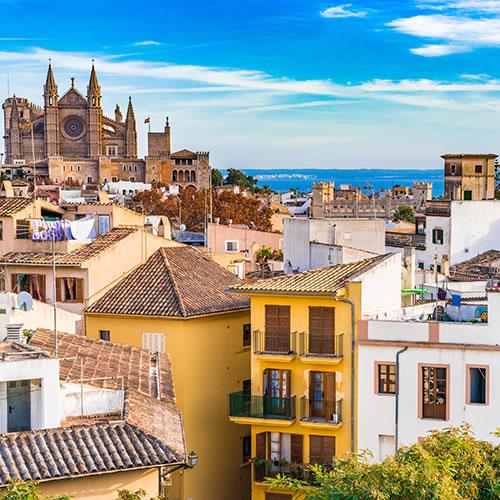PALMA (DE MALLORCA) - WHERE TO STAY




Palma (de Mallorca)
Palma
(pop. 401,270) is the capital of the autonomous community of the
Balearic Islands and the largest city on the island of Mallorca. It is
located on the southern coast of Mallorca, five miles west-northwest
from Palma de Mallorca Airport (IATA code PMI). Palma was founded as a
Roman settlement in the second century BCE, and was Rome`s connection
to the colonies in Northern Africa such as Carthage. By the year 902
CE, the Moors conquered Mallorca and Palma was renamed Medina Mayurqa.
The Aragonese captured Mallorca on New Year`s Eve 1229, and soon after
Palma became the capital of the Kingdom of Majorca. The
second-generation monarch, James II, commissioned the construction of
two key tourist attractions: Bellver Castle and the Cathedral of Santa
Maria de Palma. In the centuries that followed, Palma flourished as a
key trading post on seafaring routes traveling to Venice, Barcelona,
Provence, and Northern Africa. By the eighteenth century, the Spanish
crown took over formal administration of the Balearic Islands, and
Palma was named the capital of the region in 1833. By locals, Palma is
referred to simply as the Ciutat (Catalan for `city`).
Palma is surrounded by two ring roads. The outer ring road is the
Mallorca-20 motorway, which encloses 35 neighborhoods in an area 3.5
miles from west to east and 2.5 miles from north to south. The inner
ring road goes by a number of names: from east to west, these names,
among others, include Avinguda de Gabriel Alomar, Avinguda d'Alexandre
Rossello, Avinguda de Joan March, Avinguda del Comte de Sallent,
Avinguda d`Alemanya, Avinguda de Portugal, Carrer de Ramon y Cajal,
Carrer Comte de Barcelona, and Carrer d`Espartero. The main waterfront
road is the Mallorca-19 motorway, also called the Avinguda de Gabriel
Roca. The Santa Catalina, Paseo Maritimo and La Calatrava neighborhoods
are located along the waterfront; further inland, but still inside the
inner ring road, you will find the Monti-Sion, La Seu, Cort, Sant
Nicolau, Sindicat, Sant Jaume and Mercat neighborhoods. Along the upper
edge of the inner ring road, you will find the Estacio Intermodal, on
the Placa d`Espanya. This is a transportation hub for the southern
coast and also links Palma to the interior and northwest coast.
Points of interest close to the waterfront include the Es Baluard
Modern Art Museum, the 15th-century Gothic Llotja de Palma, the
Cathedral of Santa Maria de Palma, and the fountain at Parc de la Mar.
Out of the numerous plazas (spelled placa in Catalan), perhaps
the most noteworthy are Palma Square and Placa Major. Bellver Castle is
located 1.6 miles west of central Palma.
El Terreno
The area around Bellver Castle, to the west of Palma's old town, is referred to as "La Terreno" and is known as the town's marina district, as La Terreno is directly on the western side of the Port de Palma. While the Avinguda de Gabriel Roca runs directly parallel to the waterfront, you will find that many of the accommodation options, including 4 and 5-star resorts, are located one street behind, along the Avinguda de Joan Miro. Palma's bus system also stops frequently along Avinguda de Joan Miro, so the El Terreno area is easy to navigate even if you don't have a car. To reach Bellver Castle from El Terreno, take the Carrer Bellver from Avinguda de Joan Miro.